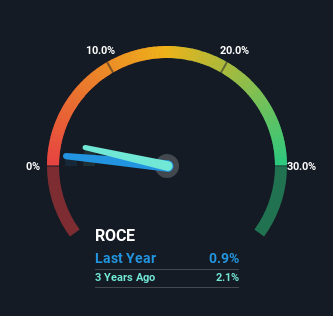
There are a few key trends to look for if we want to identify the next multi-bagger. Firstly, we'd want to identify a growing return on capital employed (ROCE) and then alongside that, an ever-increasing base of capital employed. This shows us that it's a compounding machine, able to continually reinvest its earnings back into the business and generate higher returns. However, after briefly looking over the numbers, we don't think Diwang Industrial Holdings (HKG:1950) has the makings of a multi-bagger going forward, but let's have a look at why that may be.
Return On Capital Employed (ROCE): What Is It?
For those who don't know, ROCE is a measure of a company's yearly pre-tax profit (its return), relative to the capital employed in the business. To calculate this metric for Diwang Industrial Holdings, this is the formula:
Return on Capital Employed = Earnings Before Interest and Tax (EBIT) ÷ (Total Assets - Current Liabilities)
0.0093 = CN¥6.2m ÷ (CN¥785m - CN¥123m) (Based on the trailing twelve months to June 2024).
Thus, Diwang Industrial Holdings has an ROCE of 0.9%. Ultimately, that's a low return and it under-performs the Chemicals industry average of 6.0%.
See our latest analysis for Diwang Industrial Holdings

While the past is not representative of the future, it can be helpful to know how a company has performed historically, which is why we have this chart above. If you want to delve into the historical earnings , check out these free graphs detailing revenue and cash flow performance of Diwang Industrial Holdings.
How Are Returns Trending?
In terms of Diwang Industrial Holdings' historical ROCE movements, the trend isn't fantastic. Over the last five years, returns on capital have decreased to 0.9% from 27% five years ago. Although, given both revenue and the amount of assets employed in the business have increased, it could suggest the company is investing in growth, and the extra capital has led to a short-term reduction in ROCE. And if the increased capital generates additional returns, the business, and thus shareholders, will benefit in the long run.
The Bottom Line On Diwang Industrial Holdings' ROCE
In summary, despite lower returns in the short term, we're encouraged to see that Diwang Industrial Holdings is reinvesting for growth and has higher sales as a result. Despite these promising trends, the stock has collapsed 85% over the last three years, so there could be other factors hurting the company's prospects. Regardless, reinvestment can pay off in the long run, so we think astute investors may want to look further into this stock.
If you'd like to know more about Diwang Industrial Holdings, we've spotted 3 warning signs, and 1 of them is potentially serious.
For those who like to invest in solid companies, check out this free list of companies with solid balance sheets and high returns on equity.
Have feedback on this article? Concerned about the content? Get in touch with us directly. Alternatively, email editorial-team (at) simplywallst.com.
This article by Simply Wall St is general in nature. We provide commentary based on historical data and analyst forecasts only using an unbiased methodology and our articles are not intended to be financial advice. It does not constitute a recommendation to buy or sell any stock, and does not take account of your objectives, or your financial situation. We aim to bring you long-term focused analysis driven by fundamental data. Note that our analysis may not factor in the latest price-sensitive company announcements or qualitative material. Simply Wall St has no position in any stocks mentioned.